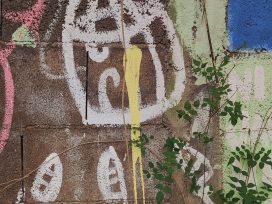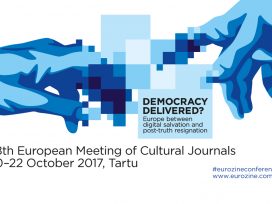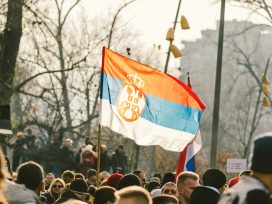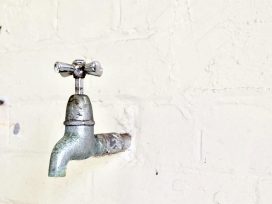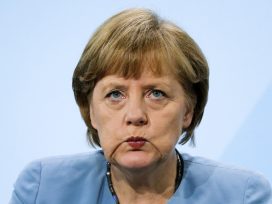On my way to Brussels, walking through the airport, the unbearable lightness of my EU citizenship made itself felt with singular clarity. The airport floor was smooth and bright and there was nothing to impede my progress across it. My suitcase was new, the kind with four wheels, and it sailed before me at a touch. It was 2015 and I was encumbered by nothing, not even my own suitcase.
For one year, I would be exploring the links between historiography, cultural cooperation and the idea of cultural heritage in the very European Union of which I myself am a citizen. What images of its historical identity, what shared cultural heritage does the EU produce? I kept this question with me as I travelled, read and discussed my way across the terrain of Europe and Europeanness. The road proved to be more circuitous than I had expected, and hemmed in on all sides by the present day. The news was all about displaced refugees and European politics was all about our collective inability to help them.
It was a year when the reception, or rejection, of refugees snaked like a live wire past train stations, sports clubs, dinner tables, government offices, symposia, talking heads, public demonstrations, theatre stages, lawmakers’ lecterns and EU summits. It got tangled up in barbed wire in Hungary and it linked up activists from Lesbos to Västerbotten. Social media were swollen with hate, fear, rumour, solidarity and grassroots organizing.
Corpses had been washing up on European shores for years – the bodies of people who, having no better path to Europe, had cast themselves upon the waters of the Mediterranean. We were witnessing an ongoing shipwreck. Rescue operations were staged, but it felt as if most of us were still on the beach, watching – or turning our backs. Not only in politics, but also in art and culture, the fate of refugees was the defining issue of the day. Few of them would have wanted it to be so. And those of us who, as Lyndsey Stonebridge put it, still considered ourselves ‘happily at home’ were in turn to be defined by our response to the refugees’ fate. In Europe in 2015, it seemed possible to revise the old cliché that art is about ‘the human condition’. Art was about the state of being a refugee, and perhaps above all about what it means to be an onlooker to this fate. These artistic expressions, and their propensity to make headlines, returned what has often been missed in politics: emotion, not to say passion.
Historical identity and cultural heritage
Recent decades have brought both conflicts and turning points in European integration. Once again, the ‘European project’ (a term fuzzy enough to describe a number of different and differently defined phenomena) was challenged, this time with much more intensely nationalist rhetoric than previously. Most importantly, this rhetoric seemed to resonate much more strongly than in recent memory. It presented the ‘European project’ as simultaneously threatened and threatening. The project was supposedly under threat from Islam as a religion and a practice (or perhaps just a culture spread by Muslims); meanwhile, it threatened true Europeans with supranationalism, forced integration and open borders.
Then, of course, the name itself clearly suggests the possibility of an end in sight. A ‘project’ seems a reasonably easy thing to conclude, compared to a nation-state. Yet that is just what the European project of today is composed of: nation-states, divided and reunified, new and reconstituted.
In exploring contemporary culture and a European identity that relies heavily on history, I had to confront questions about the connection – or the contradiction – between history and cultural heritage. Today, cultural heritage is something that offers concrete links between written history and places and people. All the talk about cultural heritage and all the activity surrounding it have invested history with a heightened importance. Academic engagement with cultural heritage has increased and, above all, broadened out. The primacy of archaeology is being challenged, although a strong and clear link to physical environments remains; that is, to buildings and cultural landscapes, to the relics of our past. In this way, even things that are now lost or altered in meaning have been preserved in our consciousness and in our physical surroundings.
Increasingly, cultural heritage is also considered to be intangible. The focus then switches from preserving artefacts to preserving cultural expressions – memories, songs, games, cuisines. Through the establishment of organizations such as UNESCO, cultural heritage has achieved a global, normalized status, and its institutionalization at an international level took place during the same postwar era that witnessed the emergence of the European Union.
One way to think about the difference between the production of cultural heritage on the one hand and of historiography on the other is in terms of the target audience for each practice. Both practices share a common object – the past. The major difference between them is that cultural heritage claims to have people who inherit it. But neither history nor cultural heritage is produced in a vacuum. The past is almost infinite, and so are its traces in the present. We choose what to remember, publicly and collectively. But who exactly chooses what? The idea of Europe, as entity and identity, has always been rooted both in its origins and in its ’others’. Now it must also be tied to an institutionalization of politics and economy on a new European level that is without historical precedent. Memory, history and cultural heritage must be produced at that same level, to create a clear European past and a clear European future.
The search for a European identity
European identity may be elusive, but it is not a figment of the imagination. We can criticize it, call it impossible, vulnerable or destructive; we can hate it, but it does exist. The problems of assembling a common European identity out of multiple national stories and identities, each a construction in its own right, are obvious. Is it even possible to unite or sum up French, Slovenian, Finnish and other nationalities so that, collectively, they become something new? No; most observers would deem it impossible. European identity is not one thing, not easily bounded. This does not exclude the possibility that multiple identities might exist which are all in some sense European. Thinking of one’s self as ‘European’ has not yet replaced a sense of national or other collective identity, but it has become more and more common.
I will not go into what this might mean for individuals. Instead I will focus on two kinds of ‘Europeanness’. Although these do not by any means represent the full complexity of the concept, they may help clarify the many different ways of talking about it. One European, supranational identity exists that is clear and obvious. It manifests itself in the many institutions set up to do European policy and administration, and of course in the people active in that immediate sphere. Its limits are not easily defined and I will not try to define them. But European integration has come far enough for most political organs in the countries of Europe – even those that are not EU member states – to engage at this level in some way. One example is university networks promoting research and education. Cultural institutions network and cooperate enthusiastically at a European level, in film, music and other areas. More independent cultural practitioners are entering into and helping to create such European spheres. Additionally, there is a dynamic here that is shaped by the availability of public funding at a European level, which in turn helps structure the ways that research, arts and cultural projects are formulated and carried out. Most of these activities and the associated actors possess European credentials. To varying degrees and sometimes in varying ways, these actors can be identified as a kind of European elite. Rarely, if ever, are they called ‘EU migrants’, although it is a given that they will move across European borders and through European space.
There is another variant of Europeanness. For lack of a better term I will call it a subcurrent, though such metaphors are as dangerous as they are seductive. It runs underneath the robustly organized, elite-oriented type of mobility and European identity: it is the migration to and through Europe of people without the proper credentials, without the necessary papers. Various forces propel them. One is helplessness, created by European poverty and in some cases clearly linked to the fact that far from all European residents have direct access to all of the rights attached to social citizenship in a nation-state – the nature of which varies widely. Perhaps the most obvious example is Europe’s Roma, whose economic and social marginalization has been recreated throughout the centuries and across shifting social, political and economic systems. The oppression of the Roma has varied in intensity, but it is probably impossible today to find any place or time where it has not been at work.
Immigrants from non-European lands also become part of something European. Some live as migrants in a shadow world with nothing to gain from even trying to reach the surface of European society. Nonetheless, they are now a fixture in many major European cities; they are labour in the service and agricultural sectors, commodities in the sex trade. Go to the Trocadero in Paris to see the Eiffel Tower. Who sells you your souvenir? The young African men who supply tourists to try and support themselves. Eiffel Tower figurines: with or without flashing lights, ‘only a euro!’ These people do not cross borders easily; far from it. But cross them they do. Asylum-seekers, by contrast, are registered and documented to a nearly abnormal degree. Their presence, their life in stasis in camps and at stations across Europe, is the human face of the ‘refugee crisis’, even though we know that they who have been able to seek protection and a life here represent only a tiny fraction of all those who would like to do so. They lead a fundamentally insecure existence. Both of these two kinds of Europeanness, these two different European identities, are also shaped by ideas about the nature of Europe itself.
Athens – Gothenburg – Berlin
Perhaps this would be the year I really became a ‘European’? The thought crossed my mind as I sat in the audience at a conference in Gothenburg, convened by Cultural Action Europe (CAE) and bringing together participants from across the continent. CAE participates in the kind of European identity I have called supranational. It is active in the cultural sector, has significant EU funding, interacts extensively with formal institutions, whether nationally or on the EU level, and also maintains distinctive ties to independent actors. More than half way into 2015, it was obvious that the refugee crisis had transcended politics to become the lens through which we viewed the world. Just over a month ago, a further conference convened by CAE, this time on European cities, culture and activism, had been cancelled at the last minute when Greece announced a snap election. I already had my ticket to Athens, so I made the trip anyway. Instead of the conference venue, I spent election night with Greek friends. My contributions to the talk that evening about politics and the election sounded to me hopelessly naive. The Greeks among us seemed so cynical, so scarred by recent events. Or was it by their entire political lives?
The next day I accompanied one of them, Petros, to a meeting. Like many people I had met, Petros had been working hard all summer helping receive the refugees streaming into Piraeus and Athens. The meeting was crowded; the participants filled several rooms and a microphone circulated. Petros tried to translate and sum up for me. It all seemed very concrete. Someone reported on a downpour that had led refugees in a park to seek shelter in a subway station. The city had closed the station to subway travellers. The refugees could stay there overnight. The question was what would happen in the morning. Others reported on who would be going to Lesbos. Doctors were a high priority. One point of discussion was the occupation of a building, previously a large hotel, which now stood empty in the wake of the crisis. Activists were turning it into a shelter. Autumn was coming. When I left the meeting a few hours later, what I felt was not cynicism. Or perhaps it was, a little, when I could not help asking my friends if the activists were cooperating with the authorities to help the refugees. ‘No’, they replied. ‘We’re too busy getting things done’.
My search for European identity, for settings where people gathered as Europeans and acted in explicitly European contexts, brought me back a few months later to another CAE conference. This time, in Gothenburg, there was no snap election to inconvenience the Brussels-based organization or their Swedish co-organizer, the County Council of Västra Götaland.
Participants could choose from parallel sessions on a variety of interesting subjects. I signed up for the group discussing ‘Future scenarios for Europe’. Someone would lead us through a process of generating ideas about Europe 2030. We split into small groups. I chose the largest, on ‘Citizen participation’. The discussion was tentative at first – like a workplace exercise in cooperation where most of the co-workers are not previously acquainted. But the pace picked up, and after a while I was genuinely excited to be there, alongside a very young British assistant to an MEP, a theatre professional from Kosovo, a Slovenian museum director, another British cultural worker and long-time grassroots organizer, and many others. I could not let go of the idea that the most important thing for Europe’s future was how we would later remember the situation as it stood in autumn 2015, how we would situate it in our collective experience. I started to enthusiastically for a ‘heritage route’ through Europe, mapping the chains of people, both individuals and activist organizations, who helped, followed and watched the path from South to North, through Europe in 2015, the continent’s year of disgrace. The ‘cultural routes’ established by the Council of Europe were at the back of my mind. I thought this particular pattern of movement deserved to enter our cultural heritage. I thought we should raise memorials to mark it.
I do not think I managed to convince my group. But I was on fire with the idea: what if ‘we’ could develop this? See it as a new variant of transcending borders? Make it into one of our common narratives? I think I even believed that the process itself, the transformation into cultural heritage, would offer not only the commemoration of a long series of humanitarian actions, but also a way out. Or back? In any event, perhaps neither my persuasive powers nor the time or the place were right. The events of autumn 2015 are not a memory. They are ongoing.
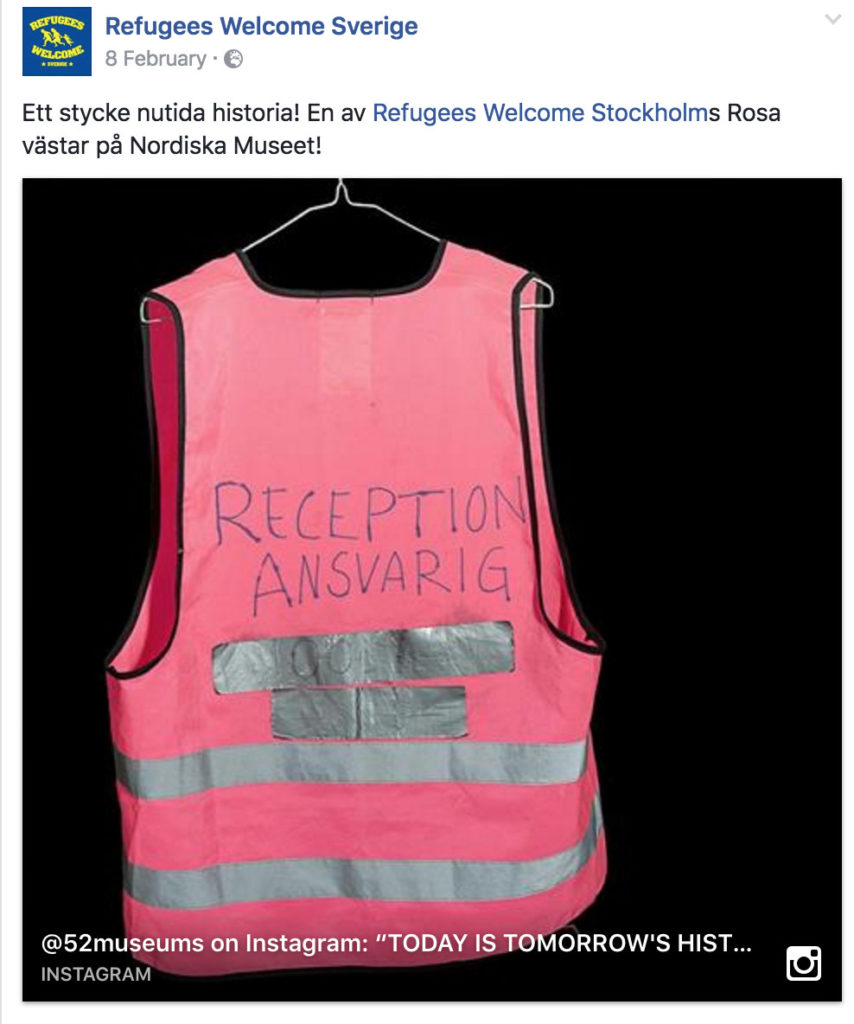
Image: Ann Ighe
Meanwhile, cultural heritage professionals across Europe preceded me. On 21 January 2016, Sweden’s Nordic Museum announced that it had documented the reception of refugees in Stockholm Central Station and added a reflective vest and an armband from Refugees Welcome to its collections. But I wondered if focusing on volunteer efforts mainly served to preserve our culture of sentimentality. Was this at heart a narcissistic reaction, an act of self-congratulation? Perhaps it was a necessity.
Is a different kind of Europe possible?
In 2015 it was the eurosceptics, mostly but not exclusively rightwingers, who made the biggest gains in public support. It was they who challenged Angela Merkel when she declared ‘We can do this’. Then, in early spring 2016, the former Greek finance minister Yannis Varoufakis launched a new initiative: Democracy in Europe 2025, DiEM25. It was one of the few projects claiming to see a way forward for European integration not backed by the EU. To let the EU collapse would be to court disaster, said Varoufakis, himself a vehement critic of the euro. Even after his painful time in the Greek government, which had been forced repeatedly to its knees by both the European Commission and the European Central Bank, he was still genuinely trying to create a new European political project. Given the centrality of the Greek crisis for DiEM25, the location for the launch party was significant: the venerable Volksbühne theatre in Berlin. A well-attended press conference was followed by sessions with invited activists, intellectuals and politicians, capped by an evening event that included a screening of a film advertising the project and many short speeches. The DiEM25 manifesto made simple demands: no return to the nation-state. Democratize Europe. Make decision-making transparent. Drop austerity.
I listened to the press conference that day. I sat in the audience that evening. I heard no contribution that did not mention the refugee situation, or more accurately the enormous shame that many of the speakers felt about its characteristics and causes, as well as some of the responses that the crisis had elicited: the Mediterranean dead, the political impotence and equivocation of EU leaders, fascism. On both the Left and the Right, the refugee situation emerged as the foremost common symbol of the European crisis.
I do not know how many times I heard it said in 2015: ‘Not since World War II have so many people been forcibly displaced’. The war years before 1950 – let us include 1914–1918, the interwar period and World War II – were experienced by an aging generation as the end of an era in terms of a European identity and way of life. It had been a way of life basically reserved for the middle classes, whose foremost interpreters were a group of (mostly male) writers and intellectuals: Walter Benjamin, Stefan Zweig, Paul Valery, to name a few. They travelled across and wrote in and about a Europe, about a European existence that was destroyed before their eyes. Up rose nationalism and national identity: Europe’s fearsome offspring. Now, a century later, we may be forced to realize that these phenomena have become Europe’s fearsome parents.
Two official narratives
For years I have been fascinated by the vision of a new museum of European history posted on the European Parliament’s website. The opening of the House of European History was initially scheduled for 2014, but repeatedly postponed. I was finally able to arrange a meeting with the museum project manager in the summer of 2016. I also took the opportunity while I was in Brussels to visit the Parlamentarium, which is the visitors’ centre of the EU Parliament and open year-round. The Parlamentarium is an attempt to address and ameliorate one of the EU’s problems – its failure to communicate (as opposed to its oft-cited democratic deficit). The art historian Caspar Pearson claims that the exhibition at the Parlamentarium wants us to believe in a European ‘cityscape’, in which national boundaries are erased and cities come to the fore. A Europe is offered that embodies the motto adopted by the EU in 2000: ‘united in diversity’.
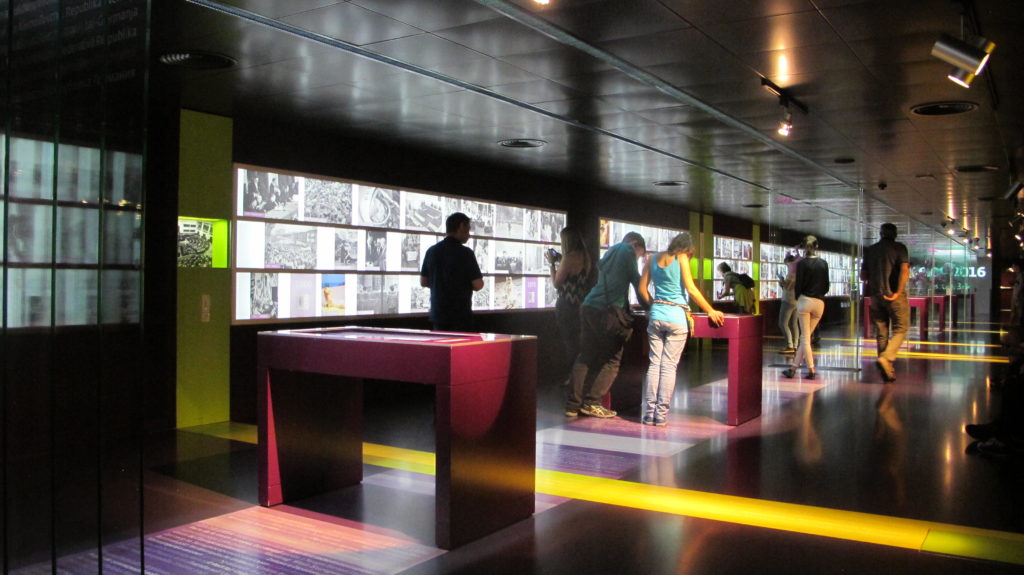
Image: Ann Ighe
To reach the Parlamentarium’s cityscape and its detailed introduction to the MEPs and their political factions, visitors must pass through a history exhibit: a story, a narrative. First we are told ‘How it all began’. This proves to be ‘with a vision: European economic and political cooperation as a way of avoiding conflict and ensuring peace’. Next comes a string of historical events and phenomena, presented in quotations, explanatory texts and pictures, along with displays of documents connected with the so-called Schuman Declaration – the French foreign minister’s proposal of 1950, which triggered a process that resulted in the European Coal and Steel Union. After our tour of the history section, we were expected to have gleaned a knowledge and understanding of more than 50 years of European integration. We entered through a ‘tunnel of voices’ speaking in all 24 official EU languages, introducing us to the EU’s ‘multilingual heritage’.
The first part of the exhibition covers the period from World War I to World War II. It supports a historical interpretation which suggests that these are essentially related conflicts: that the First World War does not really end until the Second World War is over. Two kinds of pictures are on display. The first kind are images of mostly war-related events and destruction: the ruins of the Belgian city of Ieper, or Ypres, in 1917; the March on Rome in 1922; measurements taken by racial biologists in Germany in 1940; Jews captured by German soldiers in Poland; Soviet tanks in Budapest and Riga. There are French villagers welcoming American soldiers, women dancing in bombed-out Berlin, children playing amid – if possible – even greater devastation in Warsaw. Then there are images of an impressive array of men, and one woman, announcing in eloquent phrases that they had placed their hopes in a unified Europe: Hjalmar Branting, Winston Churchill, Barbara Wooton, Thomas Mann. The exhibition establishes an interplay between the two kinds of images, moving back and forth between the two world wars and visions of European unification: integration or barbarism. This part of the exhibition seemed to pass quickly, but it sets the tone. Time, the temporal dimension itself, seemed to be compressed and chaotic. The decades were not neatly divided, as would be the case further on.
After intervening displays showing the Schuman Declaration and related documents, the aftershocks of the wars are a palpable presence as the photography exhibition resumes. World War II is succeeded by uprisings: first the revolts against Soviet power in eastern Europe, then the wars of liberation in colonies held by the western European nuclear powers, including Indochina and Algeria. I can confidently state that here, in the Parliament’s own creation story, there is no glimmer of the complicated European colonial relationship with Africa highlighted by Peo Hansen and Stefan Jonsson. In the postwar era, however, even the Parlamentarium begins to broaden its narrative. Western Europe gets popular culture and social movements. In the 1980s, the United States and the Soviet Union figure prominently. The impending collapse of the USSR and communism in eastern Europe is thoroughly examined and a major focus of the late 1980s. With the institutionalization of the community, quotations envisioning such phenomena as a United States of Europe fade away. Information about parliamentary activities is sprinkled throughout the timeline and suggests the EU parliament’s growing legitimacy over time. If the idea behind the Parlamentarium is for school children and other groups of visitors to walk through its exhibition, then it certainly holds much for them to learn. Fragments of technological progress and social conflict are there; an infinite amount of other things are not. European integration was born in the 1900s from war and chaos. That is the takeaway message. But what is Europe’s future?
On my way out I walked through the gift shop. The national symbols of the EU member states were available for purchase in a variety of forms. The EU flag was on mugs, ties and bags. Images of euro notes were printed on tissues in neat plastic wrappers, ready for sneezing on. Rather daring, I thought, in today’s climate.
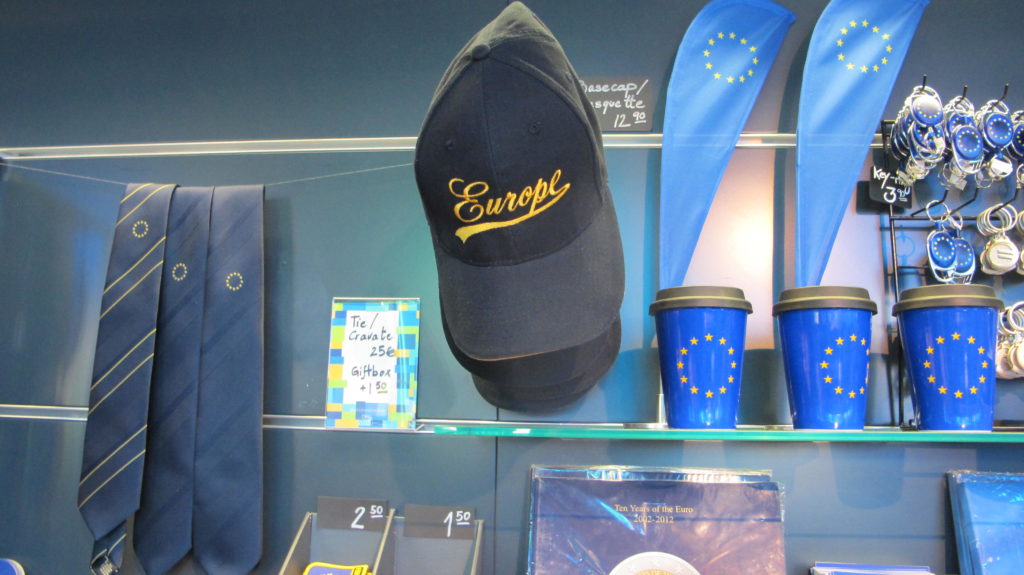
Image: Ann Ighe
The House of European History
Just a few hundred yards away, in the same quarter of Brussels, the House of European History (HEH) was still under construction. The opening was scheduled for November 2016, but even that was described as a ‘soft opening’: the official inauguration had yet to be announced. When I brought up the parliament’s prestigious new project, one reaction was, ‘If they’re building a museum to something, you know it’s about to be history’. The museum was going up even as the survival of the EU felt increasingly tenuous. I could add that museums and monuments are built to commemorate many phenomena, once they have slid into the past, but nations are not one of them. Researchers agree that monuments and commemorative acts are actually elements of nation-building. The precise nature of the EU in this connection, however, is unclear. It is neither a nation nor a state. And whereas the exhibits at the Parlamentarium are about the construction of the EU as an institution and the idea of European integration, the HEH is meant to illuminate a kind of shared, supranational European history and collective experience. Not the history of the Union itself, and not the history of the nations of Europe, as Taja Vovk van Gaal, the academic project team leader for the HEH, told me when we met at a café just outside the Eastman Building where the museum was taking shape. Vovk van Gaal is a veteran of the museum sector, having entered the field in her native Slovenia. She was slightly stressed about all the delays and the massive apparatus of the HEH project.
‘We have more than 250 contracts signed for about as many artefacts’, she said. The pressing questions were now technological: digital platforms, interactivity. The museum content, it appeared, had been duly thrashed out in the years since Hans-Gert Pöttering, then President of the European Parliament, had introduced a proposal for the museum in 2007 and a committee of experts had formulated its ‘Conceptual Basis’. In this document we find a much more extensive prehistory of the EU than is on offer at the Parlamentarium. Vovk van Gaal told me that the HEH would focus on the twentieth century and how it developed out of the nineteenth. But the experts’ preparatory work traced the roots of the EU much further back, all the way to the high civilizations of antiquity in the eastern Mediterranean and around the Black Sea – a not uncontroversial foray. Vovk van Gaal assured me that the museum’s teams enjoyed academic freedom in their interpretation of the Conceptual Basis, as in all else. But she also said it had been the hunt for artefacts that had firmed up the exhibition and its interpretation of Europeanness.
This brought her to two core principles that she and her colleagues had determined would shape the concrete content of the museum. First, the exhibitions would revolve around objects and documents, not text and images. Second, the institution would not be formally named a ‘museum’. It would be a house for European history. The HEH was tasked with depicting both European diversity and Europe’s shared roots – which of course might also be interpreted as creating the historical underpinnings for the EU slogan ‘unity in diversity’. The museum’s academic teams have worked on introductions and conclusions, the nineteenth century and its revolutions, industrialization, colonialism, social change, science and technology. Their narrative was chronological and up-to-date. It even included Brexit.
‘But it is a challenge’, Vovk van Gaal said, ‘to create a museological language for a political process that as a rule does not generate any especially exciting visual material. Another thing we have to deal with is that we know the integration process and the European institutions are not taught in the national school curricula. That means we can’t predict who will know what when they come in. And the museum is also supposed to present the EU referendums, dissatisfaction with the process of integration, and the various forms of resistance and support it has received. We want to look past the documents, which can be dull, and show how it affects people’s daily lives’.
Nationalism and how we got over it
It seemed a foregone conclusion that the twentieth-century wars would be central to the House of European History, just as they are to the Parlamentarium. It appeared, however, that an even more important narrative at the HEH would have to do with the various European national myths, identities and movements, and how they had given rise to a broader collective experience. I had brought up nationalism in Europe when I first wrote to introduce myself to Vovk van Gaal. She referred to that letter now, and to another question I had raised about the connection between nationalism and cultural heritage: ‘the nationalisms of the nineteenth century spread across Europe. People began to identify with nations, even if they did not yet live in nation-states. We want to show the roots of that national identification: the languages, the legends, the myths, the heroes.’
The museum had borrowed a series of objects to demonstrate the power of nationalist narratives in the nineteenth century. These include, to name just a few: the first collection of poems written in Romanian, published in the 1820s; the first Serbian dictionary; the first book of Slovenian grammar; a book of Czech folk songs; a copy of the Finnish Kalevala; a Latvian national epic; and the first daily paper published in Lithuanian. The collections, which mostly consist of items on loan, also include symbolic artefacts meant to represent the manifestations of nationalist cultures: glasses and plates bearing national coats of arms, an Irish freedom fighter’s cap and many similar objects. These would, Vovk van Gaal said, be displayed together, which was part of the point. I asked whether she meant that the museum would try to emphasize processes and the connections between nationalisms and their contemporary contexts, rather than the nationalist narratives themselves. Both, she said. Nationalism was important for a number of the 1848 revolutions and played a role in the growth of democracy and parliamentarism.
I asked about some points of critique that have been levelled at the museum. What people and things would it leave out? Clearly the museum was dedicated to underscoring the depth of diversity surrounding what we normally think of as European, but how would it define Europe so as to differentiate it from the rest of the world?
‘This is a theme that will be introduced immediately and run through the entire exhibition. The first thing we want to do is get visitors acquainted with the narrative of Europe as a whole. Therefore, we begin with the myth of Europa and the bull. However, the actual story of the myth is less important than showing its function as a symbol of intercontinental cultural exchange. Europa was from the Middle East. She never set foot on the continent we call Europe (the myth says she landed on Crete). This is Europe’s location: an outgrowth of the Asian landmass that has always been characterized by migrations and meetings. By the way, we will also include Cadmus, Europa’s brother, who was believed to have introduced letters and writing to ancient Greece’. And, one might add (although Vovk van Gaal did not), the original sower of dragon’s teeth. Vovk van Gaal did stress that the borders of Europe – ethnic, geographical, cultural, religions – were always shifting. She wanted to depict the crossing of borders as a central ingredient in the myth of Europe itself.
In answer to my question of what a European history really was, Vovk van Gaal said:
‘We have to present a European history, even though there is some debate about whether such a thing even exists. We think it does, of course. We have looked for shared parameters that can underpin that kind of narrative, that kind of story. It can’t just be the sum total of all the national histories. It has to be phenomena, processes, that originated in Europe and have spread across and affected Europe as it exists today.’
Vovk van Gaal stressed memory as another theme that she and her co-workers would weave into the entire exhibition. In the past she had also suggested that the HEH should not project an unambiguous European identity, but rather focus on a collective European memory. Memory was something that could be shared, forgotten and manipulated: ‘we have to deal with the ways memory and history are manipulated in our time. And yes, we are also working with heritage, and we want very specifically to tie that to the present-day. For example, if we say that the Universal Declaration of Human Rights belongs to our heritage, what are the implications for our heritage of slavery, colonialism and imperialism? What does it imply that slavery in Europe today is so widespread? We don’t want to just offer facts; we want to ask questions. If this is our heritage, what does that mean? And if slavery still exists, what does that mean for our relationship to previous generations? One of our fundamental goals for the exhibition is to get visitors to tackle uncomfortable questions like these.’
Here Vovk van Gaal touched very clearly on the risks and opportunities that exist whenever something is made into and portrayed as an important historical phenomenon whose end is imbued with special significance. Slavery is a clear example. The phenomenon becomes trapped in history, as if it had no points of contact with the social practices of today. The role of a museum undoubtedly risks reinforcing this process, but museums also and do try to counteract it. Some people are downright dismayed that so many of today’s museums work so hard to demonstrate their contemporary relevance.
I asked about criticisms raised by academics a year before the museum’s then-imminent opening. Some feared the museum would fail to sufficiently scrutinize migration and exclusionary mechanisms in European societies. Vovk van Gaal defended her team’s work and said that migration and the mechanisms of social exclusion were incorporated throughout the exhibition: ‘We are going to show migration from farming societies to urban industrial areas. We are going to show emigration from Europe in connection with industrialization. We also show the forced migrations of World War I and the millions of displaced people during and after World War II. And we have two artefacts from the current refugee crisis: a child’s shoe in a glass jar, and a book. We think it is a Koran but we’re not sure. The water damage is so extensive.’
I also asked how the museum teams had discussed the problem of developing a narrative of European history so closely tied to today’s European Union, whose historical existence we know so little about. She replied: ‘the historical progress of European integration is one of the narratives in our permanent exhibition. One of the groups we want to target with a history of European integration (i.e. of the EU) is people visiting from member states entering as recently as 2004. For them, getting this information is especially important. Therefore, we created 15 milestones of the integration process, beginning in 1848. They mark various movements and finally political developments, beginning with the decision of the first six countries to cooperate more closely after World War II. We always want to be very clear that it was never possible to forecast the direction it would take. We don’t want to contribute to a teleological historiography.’
Vovk van Gaal had written about this before, as well as about what she went on to say about the first artefact acquired by the HEH for its permanent exhibition: the Nobel Peace Prize medal awarded to the EU in 2012. Above all, she wanted to emphasize that they acquired many other objects besides: ‘We sent two of our curators to Oslo for the award ceremony, and they brought back over a hundred artefacts, including objects from the demonstrations being held outside against European austerity policies. The selection of the EU for the Nobel Peace Prize provoked a range of reactions and we try to cover as many of them as we can: the congratulatory speeches as well as the protests.’
A solution without a problem
Back at the Parlamentarium I had already started to ponder the ways in which gender relations were or were not portrayed as historical power relations. At the Parlamentarium I saw the liberation of women – exemplified in the bikini and the feminist movement – but I never saw what they were being liberated from. Perhaps this topic would receive more space at the HEH, which was planning a longer prehistory? But I wondered. The Conceptual Basis maintains a deafening silence on gender relations as a social phenomenon. It tells us that men and women in medieval and early modern Europe were divided into social and political estates, but does not mention that gender itself was an important principle by which rights and responsibilities were assigned. Male suffrage in revolutionary France is casually referred to as ‘universal’. Every actor and person mentioned by name in the document is a man. I asked Vovk van Gaal if the teams had discussed this. For the first time I was met with silence, if only for a few seconds.
‘Yes’, she said. ‘We have discussed it a great deal. Just yesterday a colleague and I spoke about it at length. And we have had some big disappointments on this front very recently. You see, our strategy has been to address it by thinking about it each time we acquire an artefact. And we just found out that we will not be able to get a painting that I think showed a woman in front of other women, and it really radiated a raw power. But we can’t get it, and instead we are getting a painting of men. It seems clear to me that for many reasons we need to devote one of the temporary exhibitions to this: to gender and to women.’
After my visits to these two different institutions, both involved in the production of European history, I thought that gender equality and female emancipation seemed to be included as a specific part of the story, separate in a way but still significative. The patriarchy and the embedding of gender inequality and subordination in early European power structures are nowhere to be seen. We learn nothing about important threads that run through the patriarchal economic system. A few landmarks, notably women’s suffrage, are pointed out: quick flashes of things that we all ought to recognize as solutions. But if the narrative does not elucidate the long and continuing dependence of European societies on patriarchal structures, then they will be flashes of solutions to a problem we do not understand.
A walk through an unfinished house
After our interview, Vovk van Gaal took me inside the museum. We walked through the rooms, many of them still empty. The nineteenth century had its own floor, but the twentieth century took up the most space by far.
In one of the rooms Vovk van Gaal exclaimed: ‘this is going to be the big challenge, the thing that provokes the strong reactions, the room about Stalinism and Nazism. Alongside the totalitarian ideologies we’re going to have displays showing how democracy ebbs and flows, wins ground and falls back.’
Standing in the mostly empty room, she shared a personal anecdote. ‘I remember sitting in Vienna in 1986 and talking about what had happened in Lebanon since the ’70s. And it was impossible not to think of my own country, Yugoslavia. All the signs were there. My friends said I was making things out to be worse than they were. They called me a Cassandra. But all the signs were there.’
I asked what she thought about the current situation in Europe. Did she think we were living in a prewar era? ‘Maybe’, she said. ‘We have the economic crisis and its effects, and nationalism is on the upswing. Maybe. But it’s hard to say’.
And that is the way of historical narratives. Only in retrospect do we realize that all the signs were there.
What then is this attempt at a European narrative? What distinguishes it from all the national narratives, besides being generally broader and crossing more borders? In itself, of course, this implies that the European narrative must include the national ones and that the competing national narratives, all formulated in relation to one another, will now be forced to jostle and rub shoulders. The museum will juxtapose them in concrete ways. Vovk van Gaal described a display about World War I. A large number of wartime postcards from various European countries are to be displayed. By showing how narratives and experiences of the same war were different in different environments, the exhibit would reach for a new understanding of the commonalities between antagonistic narratives and propaganda machines.
On not leaving crises to history
We live in an age in which many of the ideals fought for in 1968 – the ‘year of the barricades’, which is enormously important in the history of western Europe – have been embraced by the institutions of power at the European level. I say this whilst also believing that those institutions still contain everything that earlier generations fought against. But in terms of the European narrative, some of the demands of the protest generation are now represented as values in the corridors of power: gender equality, international solidarity, social dimensions, human rights, cooperation. If we are now looking for new ways of describing real social conflicts to try to help resolve them, then one of today’s problems is that, in so doing, we risk creating space for a rancorous response.
The architects of the EU accepted an enormous challenge. The community’s raison d’être is World War II; we will never escape that fact. Peace is important too, of course; peace as a goal. But even our peace is in some sense the product of war. Europe’s crises figure with incredible prominence in the historiographies of both the Parlamentarium and the new museum. Europeanness has long been defined by crises of global significance. That does not make Europe the greatest power in the world; but Europe is always important.
In the same narrative, however, European identity also springs from foresight: from the capacity to transgress boundaries, to imagine and then powerfully to will Europeanness into being from a primordial soup of incompetence, conflict and catastrophe. According to history, this is how the future was made. But when the very solution to earlier problems – European integration – is challenged as strongly as it is today, while also being so thoroughly described, this creates new tensions and new dissonances.
Europe – geography or values?
Other initiatives, including the European Commission project to communicate a ‘New Narrative for Europe’, have also recently emphasized values as a fundamental element of Europeanness. Perhaps one could argue that when the European community was in its infancy, the community between members was key, while Europeanness still had to be constructed. By 2016, the EU had expanded to cover so much of the landmass identified and identifying as Europe that the non-EU countries were now peripheral phenomena, exceptions of major or minor interest: Iceland, Norway, the perennial outsider Switzerland, the enclaves along the Mediterranean’s southern shores, the remains of large colonial territories. The location of Europe is to a great degree a historical creation that has reverberated around the world. That creation may be exaggerated. No doubt it has been. But it is Europe’s particular geographical situation and its historical power over narrative that defines America as the West and Asia as the East. Even within the difficult-to-delimit European space, the compass points remain of perennial importance. Maybe we are in the midst of an ongoing inheritance dispute over what ‘European’ really means.
Europeanness today would seem to depend more on values than before, but then again also increasingly on geography. Monitoring, guarding and ‘securing’ Europe’s borders is a mantra that has been taken up and trumpeted by governments across the EU, to such a degree that the geographical dimension of Europeanness has emerged with renewed clarity. One of our inheritances from 2015 will be borders that are once again marked and armed, and perhaps above all the knowledge that we did this in order to shut out people who had been forced to flee. What do we see when we look at our borders? Resolute, responsible action? Desperation? A chance to reconsider, to redefine human rights so that they actually liberate us all?
In Signifying Europe, his rich account of the European project and EU speak that uses the language of symbol and myth, Johan Fornäs notes the popularity of the myth of the phoenix. Again and again Europe picks itself up after a crisis; through crises it is reborn. The myth and the comparisons have been used for a long time, in relation to wars and other kinds of crises. The myth of the phoenix also lends itself well to our modern experience of recurring capitalist crises. Thus, to call attention to its meaning is to do more than just acknowledge ‘dark sides’ or ‘setbacks’. The crises themselves are part of a story about the renewal of strength and how each new crisis leads to an even better solution. The question is how to apply this narrative to the future. Must we accept and speak plainly about future crises? If so, how? And if crisis and catharsis, the death of the phoenix and its rebirth from the ashes are built into our fundamental narrative, will not any hopeful vision of a rosy future always ring false? If the stories we tell ourselves about the future do not take a clear-eyed view of conflict, they will be much harder to absorb and truly inhabit. Populism is so seductive, in part, because it dares to talk about conflict out loud.
I wonder if I dare to speak the words or set them down: a prewar era.
